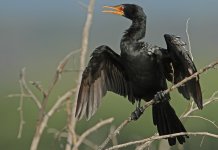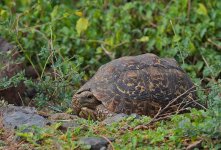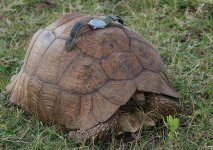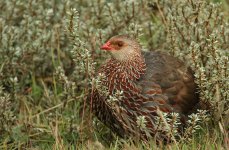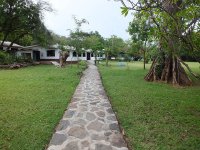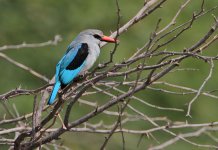Steve G
RAINBIRDER
KENYA: A Tale of Two Lakes: Lakes Baringo and Bogoria
PART 1
Rather than a full trip report this is really about our brief experience of these two lakes in 2010 and why we felt we needed to return in 2011.
Though not without its problems there are few countries in Africa that can match the range of scenic splendours found in Kenya. From snow-capped mountain peaks to arid semi-desert, from lush rain forest to endless open savannah, from cool sweet-water streams to hot caustic lakes; Kenya has got the lot! Such diversity of habitats supports a riot of life which includes most of the large mammals familiar to safari-goers. For those whose interests extend beyond the big beasts there is a huge supporting cast of birds, reptiles and smaller mammals –some of which are unique to this part of East Africa.
Inevitably it is places like the Mara, Samburu or Amboseli that attract the greatest interest. An extended road-based safari may also take in Nakuru, Mount Kenya Serena lodge or one of the Aberdares lodges whilst beach-loving tourists often undertake short safaris to Tsavo or the Shimba Hills; however, there are other hidden gems that have something different to offer. In the west Kakamega forest remains as a last lonely outpost of the long lost eastern extension of the Congo basin rain forest. In the east the Arabuko-Sokoke forest is the last large remnant of a once mighty coastal forest that extended from Somalia to Mozambique. To the north the lonely Marsabit plateau rises as a lofty green oasis from the parched dry-lands waiting patiently for the return of more peaceful times. On the Ugandan border stands Mount Elgon famous for a cave network created by elephants “mining” for salt, whilst the nearby Saiwa Swamp still supports a good population of Sitatunga. Slicing through the heart of Kenya is Africa’s Great Rift Valley, a massive geological icon characterised by mountains, escarpments, plateaus, quiescent volcanic cones and a string of lakes on the valley floor –all of which have their own identity. This is our experience of two such lakes: Baringo and Bogoria.
In July 2010 myself, my wife and our teenage daughter embarked upon a 16 day road safari travelling from Nairobi to Mount Kenya, then on to Samburu returning via Ol Pejeta from where we travelled to Baringo, then down to Nakuru and on to the Masai Mara before returning to Nairobi. We made all our arrangements through a local company called Eastern and Southern Safaris who arranged our accommodation and park entry fees as well as providing us with a 4x4 mini-bus (a much-maligned vehicle that we came to love!) and a driver/guide (the one and only Mr Benard Gitari).
This is not a full report of our trip being more a note of our experiences at Baringo in 2010 and why we felt compelled to return in 2011. That said it is worth mentioning that our time spent at Samburu, Nakuru and the Mara was particularly productive with countless lions; leopard sightings at Mount Kenya, Samburu and Nakuru; and Black Rhino seen at Ol Pejeta, Nakuru and the Mara with cheetahs also seen in the Mara.
We left Sweetwaters camp after breakfast facing the long dusty road to Baringo. As we drove to the gate to leave Ol Pejeta Conservancy we passed a small group of Jackson's Hartebeest which looked bonny in the early morning sun. On leaving Ol Pejeta we hit the open road heading west. We passed a couple of colonies of Speke's Weaver and saw numerous Cape Rooks but we had a long drive ahead with little scope for unscheduled stops. Ben did however stop by a large roadside patch of Leonotis -a weedy flower which attracts sunbirds. We saw five species including Eastern Double-collared, Variable, Bronze, Golden-winged and Malachite (these last three looking particularly impressive). I was allowed to snatch a few images before we moved on.
.......to be continued.
PART 1
Rather than a full trip report this is really about our brief experience of these two lakes in 2010 and why we felt we needed to return in 2011.
Though not without its problems there are few countries in Africa that can match the range of scenic splendours found in Kenya. From snow-capped mountain peaks to arid semi-desert, from lush rain forest to endless open savannah, from cool sweet-water streams to hot caustic lakes; Kenya has got the lot! Such diversity of habitats supports a riot of life which includes most of the large mammals familiar to safari-goers. For those whose interests extend beyond the big beasts there is a huge supporting cast of birds, reptiles and smaller mammals –some of which are unique to this part of East Africa.
Inevitably it is places like the Mara, Samburu or Amboseli that attract the greatest interest. An extended road-based safari may also take in Nakuru, Mount Kenya Serena lodge or one of the Aberdares lodges whilst beach-loving tourists often undertake short safaris to Tsavo or the Shimba Hills; however, there are other hidden gems that have something different to offer. In the west Kakamega forest remains as a last lonely outpost of the long lost eastern extension of the Congo basin rain forest. In the east the Arabuko-Sokoke forest is the last large remnant of a once mighty coastal forest that extended from Somalia to Mozambique. To the north the lonely Marsabit plateau rises as a lofty green oasis from the parched dry-lands waiting patiently for the return of more peaceful times. On the Ugandan border stands Mount Elgon famous for a cave network created by elephants “mining” for salt, whilst the nearby Saiwa Swamp still supports a good population of Sitatunga. Slicing through the heart of Kenya is Africa’s Great Rift Valley, a massive geological icon characterised by mountains, escarpments, plateaus, quiescent volcanic cones and a string of lakes on the valley floor –all of which have their own identity. This is our experience of two such lakes: Baringo and Bogoria.
In July 2010 myself, my wife and our teenage daughter embarked upon a 16 day road safari travelling from Nairobi to Mount Kenya, then on to Samburu returning via Ol Pejeta from where we travelled to Baringo, then down to Nakuru and on to the Masai Mara before returning to Nairobi. We made all our arrangements through a local company called Eastern and Southern Safaris who arranged our accommodation and park entry fees as well as providing us with a 4x4 mini-bus (a much-maligned vehicle that we came to love!) and a driver/guide (the one and only Mr Benard Gitari).
This is not a full report of our trip being more a note of our experiences at Baringo in 2010 and why we felt compelled to return in 2011. That said it is worth mentioning that our time spent at Samburu, Nakuru and the Mara was particularly productive with countless lions; leopard sightings at Mount Kenya, Samburu and Nakuru; and Black Rhino seen at Ol Pejeta, Nakuru and the Mara with cheetahs also seen in the Mara.
We left Sweetwaters camp after breakfast facing the long dusty road to Baringo. As we drove to the gate to leave Ol Pejeta Conservancy we passed a small group of Jackson's Hartebeest which looked bonny in the early morning sun. On leaving Ol Pejeta we hit the open road heading west. We passed a couple of colonies of Speke's Weaver and saw numerous Cape Rooks but we had a long drive ahead with little scope for unscheduled stops. Ben did however stop by a large roadside patch of Leonotis -a weedy flower which attracts sunbirds. We saw five species including Eastern Double-collared, Variable, Bronze, Golden-winged and Malachite (these last three looking particularly impressive). I was allowed to snatch a few images before we moved on.
.......to be continued.
Attachments
Last edited:

























